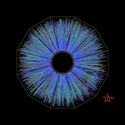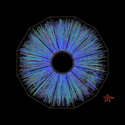The gold trail that leads to the quark gluon plasma
The quark gluon plasma (QGP) produced by gold nuclei collisions at the Relativistic Heavy Ion Collider (RHIC) has already unveiled a wealth of phenomena pertaining to this new, extreme state of matter. Understanding the QGP remains at the forefront of research efforts at particle accelerators across the world.
One of the many puzzling features observed in collisions of gold nuclei is the angular (azimuthal) correlations in the distribution of hadrons that emerge from the nuclear collisions. The spatial distribution of the hadrons should encode valuable information about the details of the dynamical processes at work in the QGP. However, this distribution appears to have an asymmetry that goes against intuition and has therefore inspired theorists to explore several hydrodynamical and phenomenological models as a means to explain it.
Writing in Physical Review Letters, Alejandro Ayala and colleagues at Universidad Nacional Autónoma de México, in collaboration with scientists also in Mexico, Brazil, and the US provide an explanation for this tell-tale asymmetry in terms of an enhancement in the production of three-body final states in two-particle collisions in the QGP. This quantum field theoretic computation is carried out within the framework of quantum chromodynamics. Apart from providing an elegant microscopic description of the azimuthal distribution, this work is also an inspiring example of the direct and fruitful exchange between theory and experiment in high-energy physics. – Abhishek Agarwal





